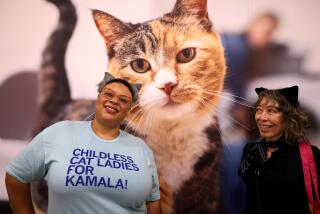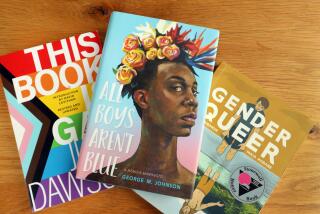Opinion: Vanessa Place’s ‘Gone With the Wind’ tweets: Artistic expression or racism?
- Share via
When Vanessa Place began tweeting Margaret Mitchell’s “Gone With the Wind,” she did it as an artistic act of provocation. And provoke she did, leading the Assn. of Writers and Writing Programs (AWP) — confronted with a Change.org petition — to drop the Los Angeles poet, conceptual artist and defense lawyer from a panel selecting participants in the organization’s annual meeting next year.
That was the wrong move. When an organization dedicated to advocacy on behalf of writers and writing programs, inherently extensions of free expression, penalizes writers for expressing themselves freely, the mission seems lost.
A bit of background: Place describes “Gone With the Wind” as “a profoundly racist text,” and she believes Mitchell crafted her book as an act of minstrelsy. From a note Place posted on Facebook after the storm welled up:
“The antebellum Southern romance with slavery is lost, mourned, and replaced with admiration for Northern speculative capital, with pure profiteering, equally race-based. Throughout, Mitchell plays the blackface minstrel, ventriloquizing blackness as the authentic counterpoint of white artifice. The black characters’ speech is written in faux dialect, proof of the book’s fidelity to its reality, and their natures are only as they appear to be …. ”
Palace’s artistic tweaking is to tweet Mitchell’s novel, which Place argues is about “the white imaginary” and appropriates the lives and experiences of enslaved blacks. She illustrated the Twitter feed with two images of stereotypes: The “Mammy” character from the film version of “Gone With the Wind,” and a clipped artwork from the sheet music for the (offensive) minstrel song, “Jemima’s Wedding Day.” To my eye, reading Mitchell’s novel a tweet at a time within that visual framework makes the inherent racism of the novel leap out.
This isn’t Place’s first artistic attack on the novel: She previously published a version of the book hoping to get the Mitchell estate to sue to claim ownership of the racial stereotypes Mitchell created. It’s an edgy approach, and whether it works as art lies in the eye of the beholder.
Then came the Change.org petition demanding the AWP bounce Place from a committee setting up speaking panels at the upcoming conference. “We acknowledge Place’s right to exercise her creativity, but we find her work to be, at best, startlingly racially insensitive, and, at worst, racist,” the petition says, then, later:
“AWP’s stated desire for inclusivity and diversity in the panel makeup requires an atmosphere of trust on the part of POC, LGBTQIA, and Disabled panel applicants, and Place’s racially insensitive, if not downright racist, projects violate that sense of trust. She furthers her career on the backs of Black ancestors — the hands that filled the master’s pockets now fill hers. We ask that you remove her from her position of authority over writers of color.”
There is much to find offensive in the words that are rolling through Place’s Twitter feed. But where does the offense belong, with Place, or with the original work? Are there calls for publishers to stop printing “Gone With the Wind?”
Interestingly, AWP didn’t cave on grounds that Place’s work is racist. It caved to the pressure:
“AWP believes in freedom of expression. We also understand that many readers find Vanessa Place’s unmediated quotes of Margaret Mitchell’s novel to be unacceptable provocations, along with the images on her Twitter page.
“AWP must protect the efficacy of the conference subcommittee’s work. The group’s work must focus on the adjudication of the 1,800 submitted proposals, not upon the management of a controversy that has stirred strong objections and much ill-will toward AWP and the subcommittee. Perpetuating the controversy would not be fair to the many writers who have submitted the proposals.”
So a messy brouhaha over artistic expression is too distracting for an organization devoted to creative free expression to handle? Free speech, and art, can be messy. The better solution for AWP: Re-instate Place and build a panel discussion around the intersections of art, racism, and offensiveness.
Follow Scott Martelle on Twitter @smartelle.
More to Read
A cure for the common opinion
Get thought-provoking perspectives with our weekly newsletter.
You may occasionally receive promotional content from the Los Angeles Times.










